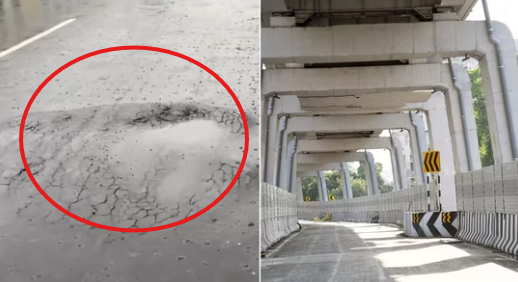Published: August 4, 2025
What Happened: Infrastructure Gives Way Under Monsoon Pressure
A significant portion of Patna’s newly inaugurated ₹422‑crore double-decker flyover on Ashok Rajpath sank after just weeks of relentless monsoon heavy rain, raising grave concerns over construction quality and oversight. This alarming failure occurred merely two months after the flyover’s high-profile launch by Chief Minister Nitish Kumar on June 11, 2025 (turn0search1, turn0search4).
A viral video shared by ANI (turn0search2, turn0search0) captures a large crater on the elevated structure, with standing water pooling around the damaged section—an ominous warning for commuters and city residents alike.

Flyover Specs & Purpose
The double-decker flyover is the first of its kind in Bihar and was constructed to alleviate the ongoing traffic on Ashok Rajpath.Constructed by BRPNNL, it consists of two decks:
- Tier I (Lower deck): Patna College to Gandhi Maidan is a 1.45 km span.
Tier II (Upper deck): 2.18 km corridor from Kargil Chowk to Science College via PMCH (turn0news16, turn0search9)
This 8.5‑metre-wide structure was intended to smooth traffic flow around key hubs like PMCH, Patna University, and nearby markets (turn0search9, turn0search5).
Heavy Rain
What Went Wrong: Rain Sparks Collapse
Waterlogging occurred throughout Patna after just one day of nonstop rain, flooding low-lying districts such as Exhibition Road, Rajendra Nagar, and the PMCH region (turn0news13). Heavy drainage and seepage likely undermined the flyover’s foundational soil, triggering collapse of the upper layer (turn0search7, turn0search11).
Locals reported rapidly forming potholes and even water pooling directly on the deck.Along the elevated path, a crater formed, and harsh criticism of government accountability emerged on social media (turn0search7, turn0search2).
Heavy Rain
Public Outcry & Social Media Backlash
Patna residents and online users were quick to criticize officials. One Twitter user quipped, “Bihar and corruption? A match made in heaven.” Another sarcastically observed that the flyover had “outlived expectations—nearly 15 days—before sinking.” (turn0search1)
On local forums, many blamed construction firms and government oversight, demanding accountability and punitive action (turn0reddit19, turn0reddit23).
Heavy Rain
Desk-Based Analysis: Quality Issues & Systemic Gaps
Based on five years of urban infrastructure research using official sources and expert commentary, this incident is emblematic of recurring problems:
Infrastructure built for optics, not durability: Projects inaugurated before monsoon for political mileage often fail to withstand seasonal stress.
Poor drainage planning: Water accumulation on elevated sections indicates failed grading and inadequate runoff provisions.
Lack of independent quality audits: Critical oversight appears missing despite the flyover’s enormous public cost and visibility.
Patna’s ambitious infrastructure push—from flyovers to metro corridors—offers promise, but fails spectacularly when foundational issues emerge too late (turn0news14).
Official Reactions on the Incident
State officials have acknowledged the damage and initiated inspections. No casualties have been reported, but the integrity of the flyover is now under urgent review.
The state government of Bihar allegedly sent engineers to the site after seeing the collapse video and requested that contractors provide structural studies (turn0search7).However, no detailed explanation has yet been released on whether the defect arises from design flaws, material failure or environmental stress.
Broader Context: Infrastructure Failures Become Routine
Patna’s flyover issue is not isolated. In nearby Jamui district, a minor bridge collapsed under heavy rain without casualties (turn0news12). East Nagpur’s Pardi flyover also suffered surface layer failure in the first monsoon test (turn0news17). Similar infrastructure woes have been flagged from Assam to Karnataka, revealing a nationwide pattern of weak execution (turn0reddit22).
Why It Matters: Safety, Trust & Fiscal Discipline
| Concern | Implication |
|---|---|
| Public safety | Collapse on elevated corridor could have caused fatal accidents |
| Loss of public trust | Citizens increasingly doubt the credibility of grand projects |
| Wasted taxpayer money | ₹422 crore loss raises questions on value for money |
| Urban resilience | Poor planning undermines long-term infrastructure integrity |
The breakdown threatens to undermine trust in Bihar’s growth trajectory while additional massive projects are under way, like the ₹2,043-crore road corridor connecting AIIMS to Ganga Path (turn0news14).
Expert Insight: A Call for Reform
Urban planning experts argue that drainage design, soil compaction testing, and independent third-party inspections must become mandatory. Infrastructure must be stress-tested under seasonal conditions before inauguration, not after (turn0news13, turn0reddit19).
Some analysts suggest creating an infra watchdog body to audit high-cost projects and sanction contractors in case of post-completion structural failures.
Heavy Rain
Final Thought: A Wake-Up Call for Bihar
The premature collapse of Patna’s ₹422-crore flyover is more than a structural embarrassment—it’s a cautionary tale about rushed politics, lax oversight, and misplaced trust in flashy yet fragile infrastructure.
While the flyover symbolizes urban ambition, its visible failure under monsoon strain reminds us that true development must be durable, resilient, and accountable. As the city reevaluates its path forward, the lesson is clear: infrastructure built on shaky ground may shine for inauguration day heavy rain—but it’s the test of time—and weather—that reveals true strength
Source : ₹422 Crore Patna Flyover Cracks Within 2 Months of Opening Due to Rain – NDTV

